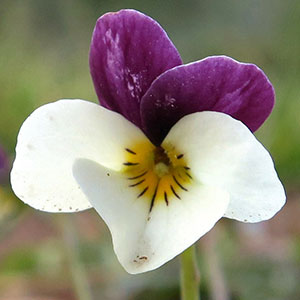Viola hallii
Viola blanda
Hall's violet, Oregon violet, wild pansy
sweet white violet, violette agréable
1–3, decumbent or ascending to erect, ca. 1/2 subterranean, glabrous, clustered on single, short, vertical, deep-seated caudex.
basal and cauline;
basal: 1–4, palmately compound, ± 2-ternate or 3-ternate, leaflets 3;
stipules adnate to petiole, forming 2 linear-lanceolate wings, unlobed, margins entire, apex of each wing free, acute;
petiole 5–8 cm, glabrous;
blade ovate to deltate, 2.8–6 × 2.6–6.5 cm, ± coriaceous, base tapered, ultimate lobes narrowly elliptic, lanceolate, or oblanceolate, 1–7 mm wide, margins entire, ciliate or eciliate, apex acute, mucronulate, surfaces glabrous;
cauline similar to basal except: stipules usually lanceolate, sometimes broadly ovate, ± leaflike, margins toothed;
petiole 1.3–6 cm;
blade 2–4.8 × 1.2–5.5 cm.
basal, 2–9, prostrate to ascending;
stipules linear-lanceolate, margins entire, apex acute;
petiole 2–11 cm, usually sparsely pubescent;
blade unlobed, reniform to ovate, 2–4 × 2–4 cm, base cordate, lobes often overlapping, margins serrate, ciliate or eciliate, apex rounded or acute to acuminate, surfaces sometimes glabrous, usually sparsely pubescent adaxially.
2.5–11 cm, glabrous.
3–11 cm, glabrous or pubescent.
sepals lanceolate to ovate, margins ciliate, auricles 0.5–1 mm;
petals: upper 2 almost black abaxially, dark reddish violet adaxially, lower 3 pale yellow, cream, or ± white, lateral 2 bearded, with deep yellow to orange patch basally, dark reddish violet-veined, lowest with deep yellow to orange patch basally, dark reddish violet-veined, 5–18 mm, spur yellow, gibbous, 0.5–2 mm;
style head bearded; cleistogamous flowers absent.
sepals lanceolate to ovate, margins mostly eciliate, auricles 1–2 mm;
petals white on both surfaces, lower 3 purple-veined, lateral 2 usually beardless, lowest 8–10 mm, spur white, gibbous, 1–2 mm;
style head beardless; cleistogamous flowers axillary.
ellipsoid, 4–12 mm, glabrous.
ovoid to ellipsoid, 4–6 mm, glabrous.
light brown, shiny, 3.2–3.5 mm.
beige to bronze, 1.5–2 mm.
= 60, 72.
= 44, 48.
Viola hallii
Viola blanda
Viola hallii was discovered on the grounds of Willamette University in Salem, Oregon, by Elihu Hall, a professor at that institution (V. B. Baird 1942). Leaves of V. hallii are similar to V. beckwithii.
(Discussion copyrighted by Flora of North America; reprinted with permission.)
Viola blanda occurs in small colonies; individual plants are interconnected by stolons.
Whether to recognize Viola incognita at any taxonomic level is currently unresolved. It is said to have pubescent
leaf blades, greenish peduncles, nontwisted lateral petals, and a preference for moister habitats. Most of these characters fall within the range of variation observed in V. blanda.
N. H. Russell (1965) noted that Viola incognita is principally found in glaciated areas whereas V. blanda is found in nonglaciated areas. Á. Löve and D. Löve (1982b) and J. M. Canne (1987) reported a chromosome count of 2n = 44; J. Clausen (1929) and A. Gershoy (1934) reported 2n = 48. V. B. Baird (1942) reported that V. blanda (and V. incognita) have fragrant flowers.
(Discussion copyrighted by Flora of North America; reprinted with permission.)


